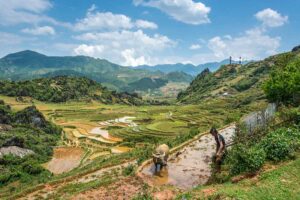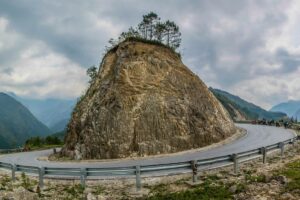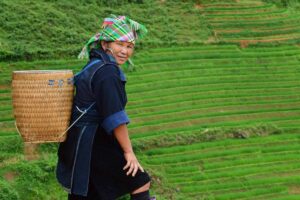When exploring viewpoints in Sapa, you’ll encounter breathtaking landscapes featuring terraced rice fields and majestic mountains. These vistas offer some of the most stunning natural scenes in Vietnam. But timing is key to experiencing the best views, as each season brings its own unique charm.
The right season for the best views
Your experience of Sapa’s views will greatly depend on the time of year you visit. Each season offers a unique perspective on the rice fields and mountains.
April / May – Watering Season
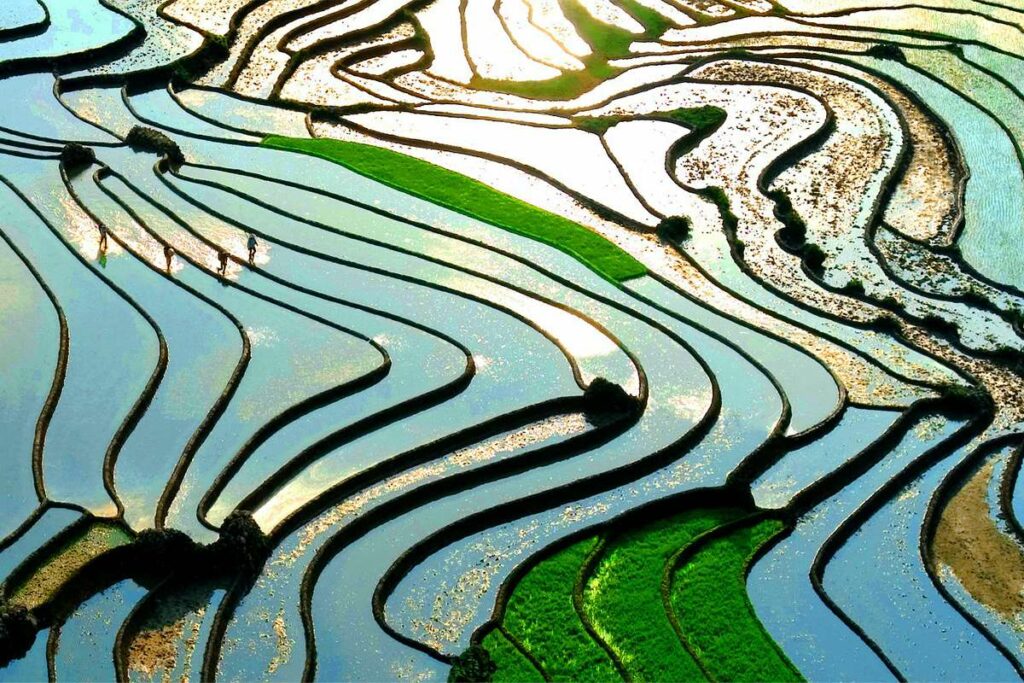
During the watering season, the rice fields are filled with water, turning the terraces into vast mirrors reflecting the sky. This creates a surreal and beautiful landscape, perfect for photography.
June – Early Growth
In June, the rice plants start to grow, dotting the fields with small, green plants. This period showcases the early stages of the rice fields, adding a fresh and vibrant look to the terraces.
July and Early August – Lush Green Fields
By July and early August, the rice fields are lush and green, stretching out in long, verdant waves. This is a beautiful time to visit if you enjoy seeing the fields at their peak of growth.
Late August and Early September – Golden Harvest

The end of August and the beginning of September is the most stunning time of year to visit Sapa. The fields turn a golden yellow as the rice ripens, and you can see ethnic people busy with the harvest. This period offers a vibrant and picturesque view of the terraces.
Late September – Extended Harvest
Depending on the year, the harvest might extend to the end of September. The fields may still have a mix of green and golden hues as the last of the rice is gathered.
October – November – Post-Harvest
Although there are no rice fields to see in October and November, the weather is generally great for trekking and exploring. The clear skies and pleasant temperatures make it a good time for enjoying Sapa’s natural beauty.
December – February – Winter Season
During winter, from December to February, there are no rice fields, and the weather can be quite cold. The increased chance of clouds can either obstruct views or create magical cloudscapes over the mountains.
March – Preparations Begin
March brings nice weather, and while there are no rice fields yet, the locals are busy preparing for the next planting season. This is a great time to see the early stages of the agricultural cycle and enjoy the pleasant climate.
Accommodations with a view
Resorts, Hotels & Lodges
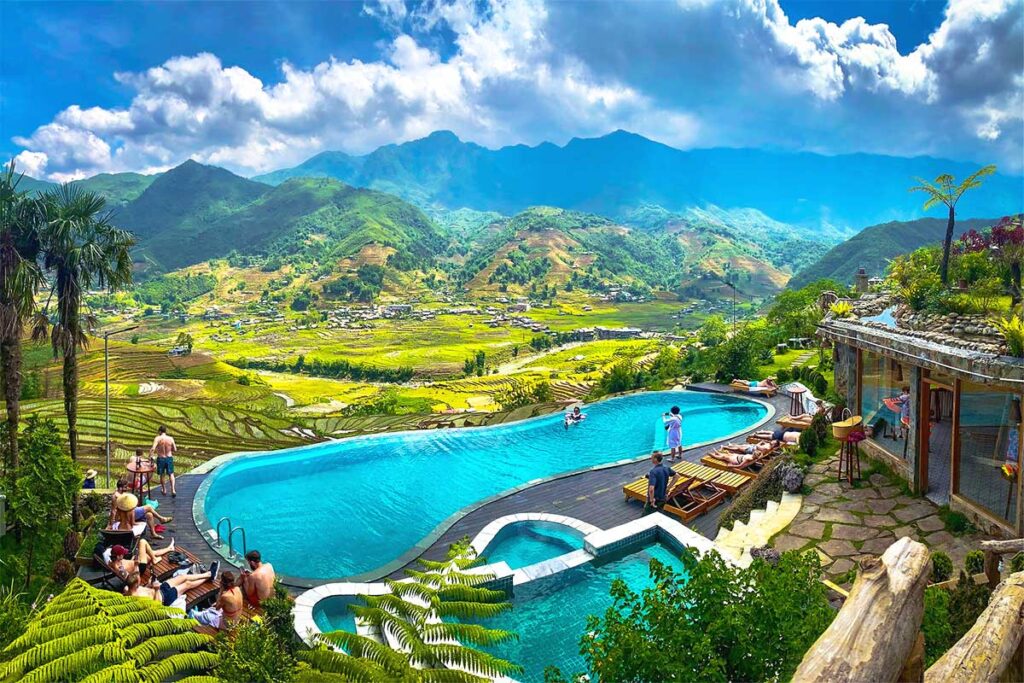
Trekking and exploring the terraced rice fields is amazing, but waking up to an incredible view from your window is hard to beat. Many hotels, lodges, and resorts with views of the terraced rice fields are located along Muong Hoa Road, starting from Sapa. Some offer the best views imaginable, with infinity pools that overlook the rice fields. While these accommodations are pricier than those in Sapa town, the experience can be well worth it. Here are a few examples of exceptional places to stay:
- Topas Ecolodge: This luxury lodge is situated atop a hill, offering panoramic views of the surrounding rice terraces and mountains. It features an infinity pool with stunning views.
- Sapa Clay House: Known for its eco-friendly design, this lodge provides breathtaking views of the Muong Hoa Valley. The rooms are designed to blend seamlessly with the natural environment.
- Silk Path Grand Resort & Spa Sapa: Located on a hilltop, this resort offers luxurious amenities and sweeping views of the rice fields and mountains. It also features an infinity pool with a spectacular view.
- Victoria Sapa Resort & Spa: This resort combines comfort and elegance with stunning views of the terraced rice fields and the Fansipan mountain range.
Also read our complete guides about accommodations with a view in Sapa:
Homestays
For a more budget-friendly option, consider staying in a homestay. Some homestays are quite charming and could easily be considered lodges, while others are very basic and run by ethnic minority families. Although the amenities are minimal, the experience is deeply enriching. Staying in a homestay allows you to live within the rice fields, interact with the local community, and enjoy family meals together.
Best Viewpoints in Sapa
1. Muong Hoa Road
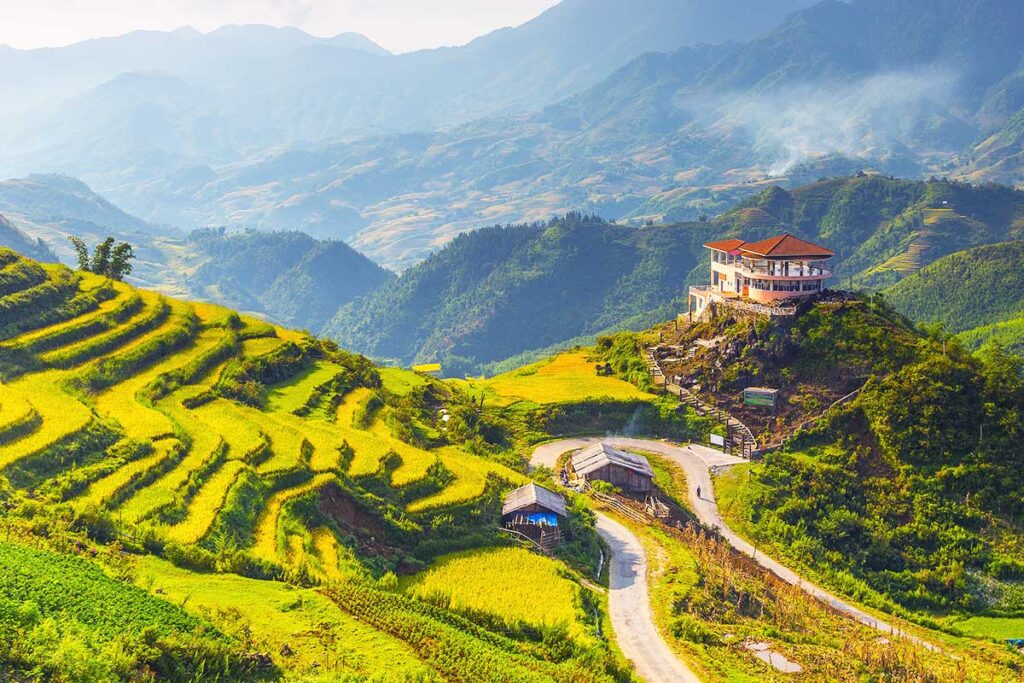
Muong Hoa Road isn’t a single viewpoint but a scenic road offering stunning views over the terraced rice fields. This road is perfect for those who cannot or prefer not to trek but still want to enjoy the beautiful landscapes Sapa has to offer. You can stop along the road to take photos or simply admire the view. There are designated viewpoints where you can park, often with ethnic minorities selling souvenirs.
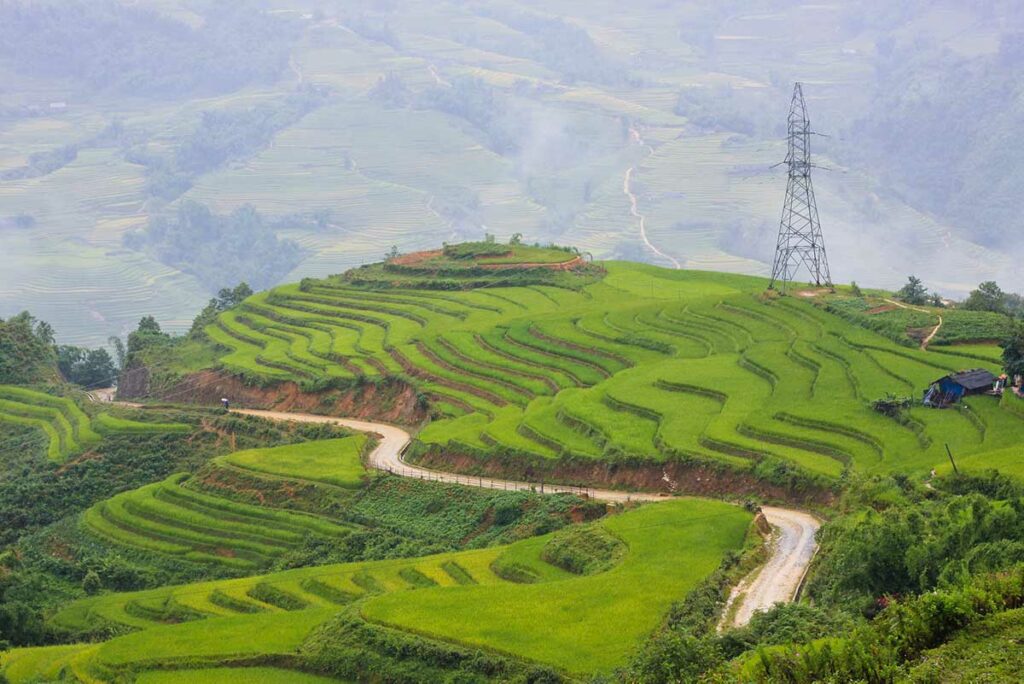
Muong Hoa Road runs through Muong Hoa Valley, renowned for its famous terraced rice fields. It’s not a busy highway but primarily used by tourists visiting the small ethnic villages in the valley. The road starts in Sapa town, and the first few kilometers are lined with lodges, hotels, and resorts, making it an excellent area to book your accommodation for views right from your window.
There are several ways to travel along Muong Hoa Road:
- Electric Cart: You can book an electric cart for an hour or longer from your accommodation. These open vehicles are perfect for getting on and off easily, taking photos, and enjoying the fresh mountain air.
- Car with Driver: Arrange a car with a driver for a fixed time or route. Unlike taxis, these drivers will stop at various spots for you and can plan an itinerary that includes viewpoints, spots, restaurants, and sights that tourists enjoy.
- Renting a Scooter: Renting a motorbike gives you the most freedom and is the cheapest option. You can stop wherever you want, but it’s not recommended if you don’t have a valid IDP or are uncomfortable with driving in the mountains of northern Vietnam.
- Hiking: Walking along Muong Hoa Road is an option, but many better trekking routes are less trafficked by cars and motorbikes and offer a more serene experience.
2. Fansipan Summit

Fansipan Summit, the highest peak of Vietnam, used to be accessible only by trekking. While trekking options still exist for both single-day and multi-day adventures, most visitors now opt for the more convenient cable car ride. To reach the cable car station, you first take a train from Sapa town.
The views from Fansipan Summit are nothing short of spectacular. On clear days, you can enjoy breathtaking panoramic views of the Hoang Lien Son mountain range, lush forests, and the valleys below. However, it’s important to note that the peak is often enveloped in clouds, obscuring the views. When this happens, the experience is still mystical and atmospheric, but you won’t get the expansive vistas you might be hoping for.
3. Tram Ton Pass

Tram Ton Pass, the highest mountain pass in Vietnam, is a must-visit for breathtaking views. This pass offers several viewpoints, each providing stunning perspectives of the surrounding landscape.
One well-known spot along the pass is the Glass Bridge, which features a very tall glass elevator. Walking over the glass floor of the bridge can be a thrilling experience, offering vertigo-inducing views of the valley below. While this can be a cool experience, it’s a bit pricey if you’re just looking to enjoy the view.
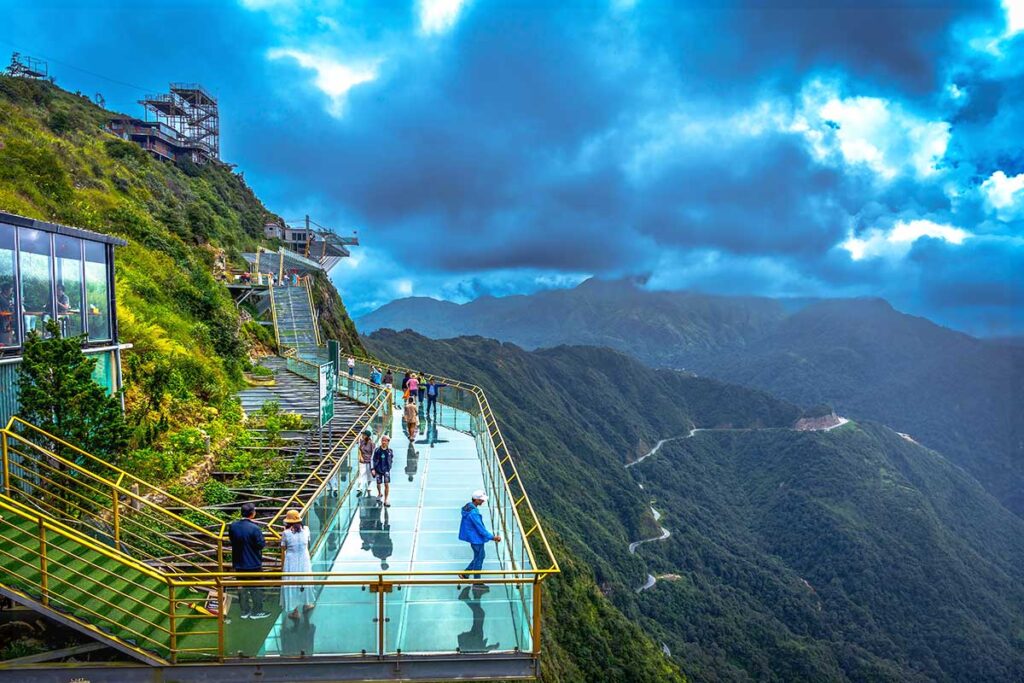
For those who prefer a more budget-friendly option, there are coffee shops along the pass with cheaper entrance fees and even better views. These spots provide a relaxing atmosphere to soak in the scenery without breaking the bank. Tram Ton Pass, with its varied viewpoints, is perfect for anyone looking to experience the majestic beauty of Sapa from different angles.
4. Ham Rong Mountain
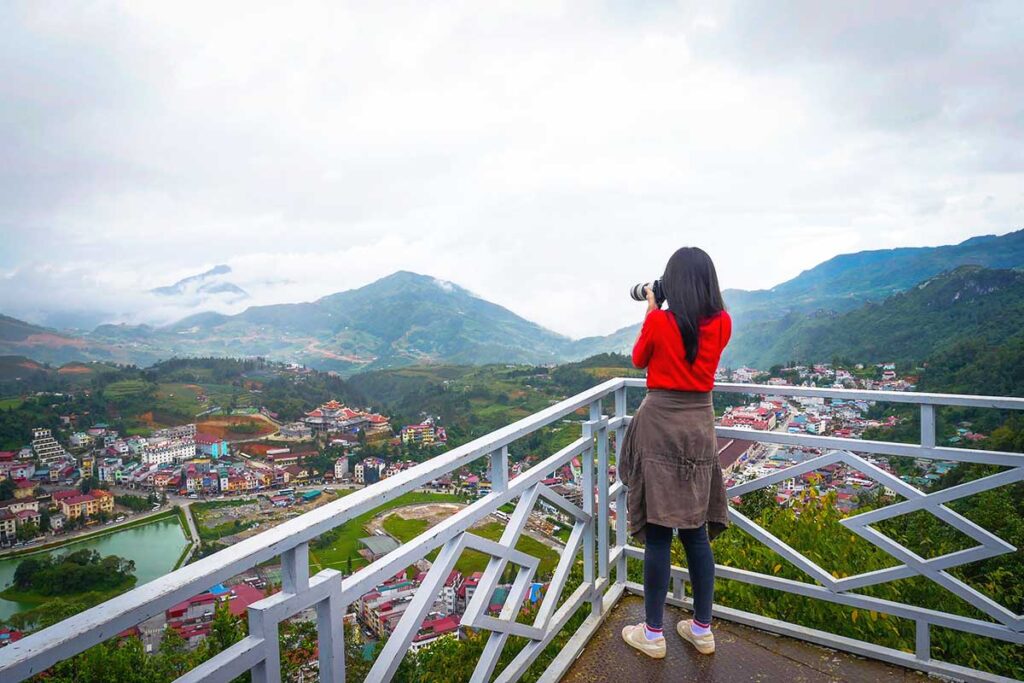
Ham Rong Mountain, located close to Sapa town, is a popular destination for its accessible and well-maintained paths leading to several viewpoints. Climbing Ham Rong offers a mix of manicured gardens, rock formations, and traditional ethnic performances along the way. The summit provides panoramic views of Sapa town, the surrounding mountains, and the expansive terraced rice fields below. The diverse flora and scenic landscapes make it a perfect spot for both nature lovers and photographers.
5. Village viewpoints
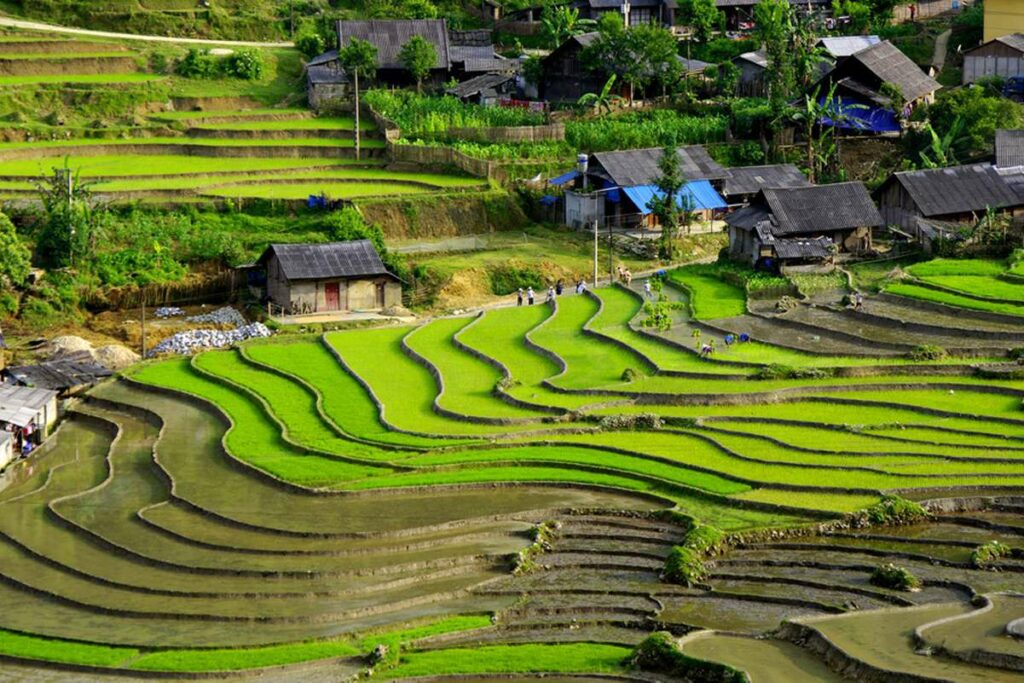
Some of the most breathtaking views of Sapa’s terraced rice fields are found within or around the local villages. These areas are connected by small paths that you can walk along to explore and enjoy the scenery. You don’t need to go to a specific viewpoint; the stunning vistas unfold along these trails. The most picturesque areas include:
- Ta Van Village: Known for its vibrant terraced fields and ethnic minority culture. The paths around Ta Van offer serene and beautiful views, perfect for a leisurely walk.
- Lao Chai Village: This village provides incredible views of the terraced fields and the Muong Hoa Valley. The trails here are peaceful, allowing you to immerse yourself in the natural beauty.
- Y Linh Ho Village: A quieter spot with equally stunning landscapes. The trails around Y Linh Ho offer a more secluded experience with magnificent views of the terraced fields and traditional Hmong houses.
Flying a drone in Sapa: Capturing aerial views
While you can’t capture the breathtaking landscapes of Sapa from an aerial perspective with your own eyes, using a drone can create stunning videos and photos. Flying over the terraced rice fields and majestic mountains of Sapa provides a unique view of this beautiful region, showcasing its natural beauty in a way that ground-level photography can’t match.
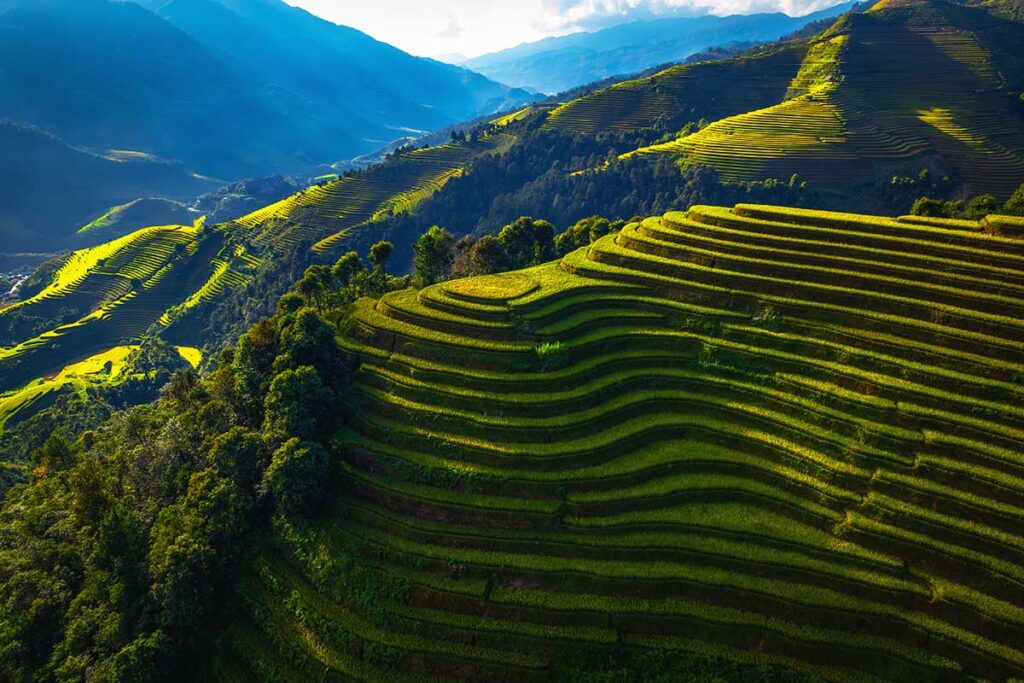
However, flying a drone in Vietnam comes with its challenges. Officially, it is illegal to fly a drone without a permit for each flight. Obtaining this permit is often a complex and time-consuming process, usually only feasible for commercial businesses. Despite this, many travelers still choose to fly drones. To avoid issues, it’s crucial to stay away from sensitive areas like police stations, military zones, and government buildings when filming.
Sapa’s Viewpoints vs. Mu Cang Chai’s Viewpoints
The viewpoints in Sapa are renowned for their stunning terraced rice fields and majestic mountains. However, many images that appear on Google and travel websites, supposedly of Sapa, are actually from Mu Cang Chai. This nearby region is famous for having the most stunning terraced rice fields of Vietnam and often mistakenly associated with Sapa.
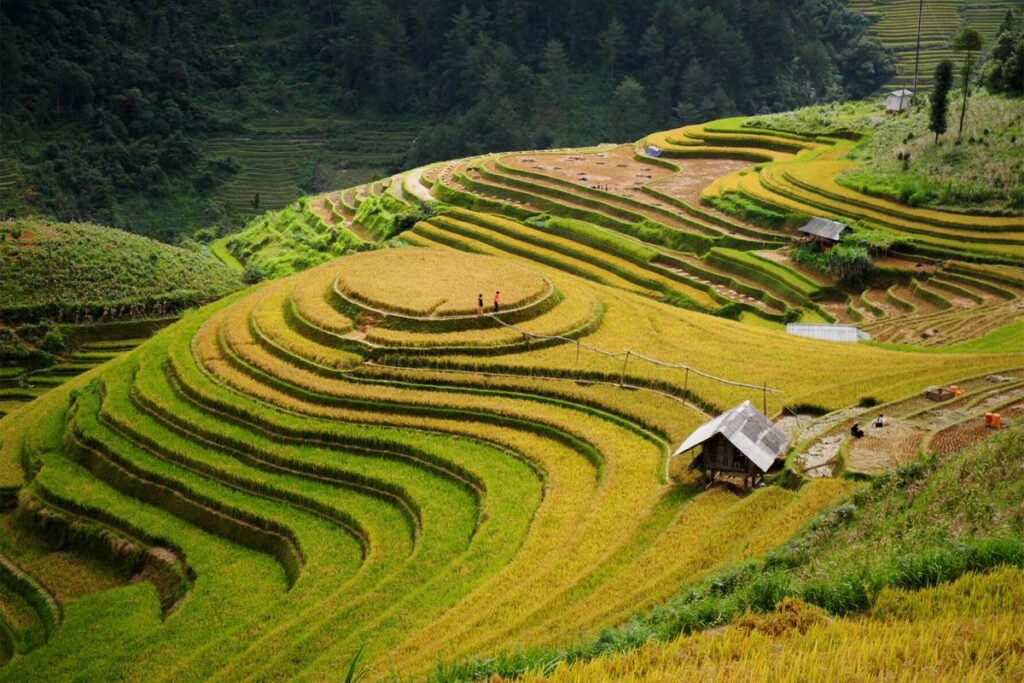

Mu Cang Chai, located in Yen Bai Province, offers a more rustic and adventurous experience compared to Sapa. It’s harder to reach and less developed, making it an ideal destination for travelers seeking non-touristic places. While Sapa has a variety of amenities and activities, Mu Cang Chai provides unspoiled landscapes and a peaceful atmosphere, perfect for those looking to explore Vietnam’s natural beauty off the beaten path.
